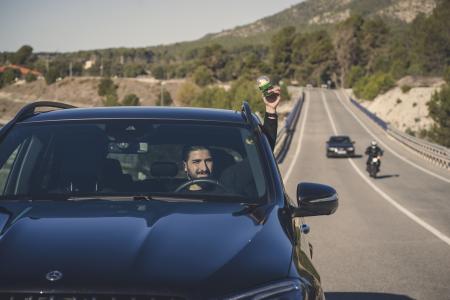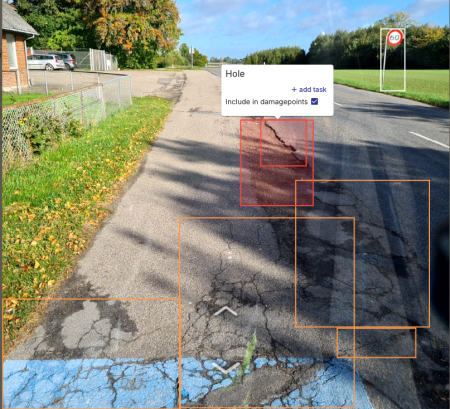Our members are dedicated to improving road safety and sharing their knowledge with the wider community. Here, you can explore our members' good practices – initiatives that have been assessed for their effectiveness in addressing a road safety problem and have proven results.
Get inspired – and sign up to share your good practices too!

Monday, June 24, 2024
Desde Erum Vial en la actualidad desarrollamos dos dispositivos conectados: la baliza V16 conectada, Led One Connected, y el Cono Conectado, Led Cone.
Con la baliza V16 se sustituye el uso del triángulo conectado, por lo que los conductores no tienen que circular por el arcén para colocar la señalización. La baliza V16 conectada se coloca en la parte superior del vehículo y conecta de manera anónima con la plataforma DGT 3.0, transmitiendo la ubicación de la incidencia y transmitiéndola a los paneles digitales de las carreteras y a los mismos navegadores.
Con el cono conectado se informa de las obras activas en carretera, advirtiendo a los conductores sobre las obras para que tengan precaución o modifiquen su trayecto. El cono conectado también es muy útil a nivel urbano para informar a la ciudadanía de cualquier incidente de manera automática.
Con la baliza V16 se sustituye el uso del triángulo conectado, por lo que los conductores no tienen que circular por el arcén para colocar la señalización. La baliza V16 conectada se coloca en la parte superior del vehículo y conecta de manera anónima con la plataforma DGT 3.0, transmitiendo la ubicación de la incidencia y transmitiéndola a los paneles digitales de las carreteras y a los mismos navegadores.
Con el cono conectado se informa de las obras activas en carretera, advirtiendo a los conductores sobre las obras para que tengan precaución o modifiquen su trayecto. El cono conectado también es muy útil a nivel urbano para informar a la ciudadanía de cualquier incidente de manera automática.
Monday, June 24, 2024
La mayoría de los itinerarios que unen los distintos núcleos de población, o los que conectan estos con los principales servicios como colegios, centros de salud o equipamientos públicos, consisten en carreteras, pensadas y diseñadas para la circulación de vehículos automóviles.
La posibilidad de desplazamiento para usuarios que circulen a pie o en bicicleta implica, necesariamente, compartir plataforma con vehículos a motor, con el elevado riesgo que esto supone para los usuarios de las carreteras.
La dispersión de la población en Galicia tiene como consecuencia que haya una importante longitud de tramos con núcleos de población, viviendas y equipamientos en sus márgenes, y que no contaban con aceras o sendas para un desplazamiento peatonal seguro. Uno de los principales retos fue el de seleccionar y priorizar aquellas infraestructuras en las que se desarrollarían las actuaciones, además de adecuarlas y encajarlas en carreteras ya existentes, formando una infraestructura apta y segura para la circulación de vehículos automóviles y de peatones y ciclistas.
La posibilidad de desplazamiento para usuarios que circulen a pie o en bicicleta implica, necesariamente, compartir plataforma con vehículos a motor, con el elevado riesgo que esto supone para los usuarios de las carreteras.
La dispersión de la población en Galicia tiene como consecuencia que haya una importante longitud de tramos con núcleos de población, viviendas y equipamientos en sus márgenes, y que no contaban con aceras o sendas para un desplazamiento peatonal seguro. Uno de los principales retos fue el de seleccionar y priorizar aquellas infraestructuras en las que se desarrollarían las actuaciones, además de adecuarlas y encajarlas en carreteras ya existentes, formando una infraestructura apta y segura para la circulación de vehículos automóviles y de peatones y ciclistas.

Monday, June 24, 2024
We’re addressing multiple road safety problems:`
- Improving the work safety of road inspectors by reducing time being physically in the middle of the road and reducing multitasking while driving.
- Improving road safety for cars, motorcycles and bicyclist by reducing potholes and defect road inventory such as faded road signs, damaged bollards, etc.
- Improving road safety for pedestrians by mapping crosswalks with worn-out lane markings as well as pavement uplift that causes people to fall.
Image examples can be found attached
- Improving the work safety of road inspectors by reducing time being physically in the middle of the road and reducing multitasking while driving.
- Improving road safety for cars, motorcycles and bicyclist by reducing potholes and defect road inventory such as faded road signs, damaged bollards, etc.
- Improving road safety for pedestrians by mapping crosswalks with worn-out lane markings as well as pavement uplift that causes people to fall.
Image examples can be found attached

Sunday, June 23, 2024
Zavarovalnica Triglav od leta 2015 ponuja mobilno aplikacijo DRAJV, ki spodbuja in nagrajuje varno vožnjo. Aplikacija z uporabo tehnologij telematike spremlja hitrost vožnje, premike telefona in sile med vožnjo. Aplikacija DRAJV prispeva k varnejši vožnji z nadzorom hitrosti, analiziranjem voznih navad in ozaveščanjem uporabnikov, kar zmanjšuje tveganja za nastanek prometnih nesreč, ki ostajajo globalen izziv. Glavni vzrok prometnih nesreč v Sloveniji je še vedno neprilagojena hitrost vožnje, aplikacija DRAJV pa tako s spodbujanjem vožnje s primerno hitrostjo pozitivno vpliva na prometno varnost, saj so aplikacijo DRAJV na svojih vožnjah uporabili vozniki 8-10 % vseh osebnih vozil v Sloveniji.
En večjih globalnih problemov je tudi uporaba mobilnega telefona med vožnjo, kar povzroča neosredotočenost na dogajanje v prometu in močno povečuje tveganja za nastanek prometne nesreče. Aplikacija DRAJV spremlja in ocenjuje tudi pogostost uporabe telefona med vožnjo in nagrajuje voznike, ki telefona med vožnjo ne uporabljajo.
Aplikacija DRAJV obravnava glavne izzive varnosti na cestah, kot so prekoračitve hitrosti, uporaba telefona, sunkovita pospeševanja, zaviranja in vožnje v ovinek. Aplikacija je posebej prilagojena tudi za voznike motornih koles in tako spodbuja varno vožnjo motoristov, ki so med najbolj ranljivimi udeleženci v prometu.
Na podlagi anonimiziranih podatkov voženj uporabnikov, ki so skupno prevozili več kot 1,6 milijarde kilometrov, smo izdelali tudi interaktivno spletno orodje »DRAJV zemljevid«, ki identificira nevarne cestne odseke v Sloveniji z vidika hitrosti vožnje in drugih parametrov, ki jih spremlja aplikacija DRAJV.
En večjih globalnih problemov je tudi uporaba mobilnega telefona med vožnjo, kar povzroča neosredotočenost na dogajanje v prometu in močno povečuje tveganja za nastanek prometne nesreče. Aplikacija DRAJV spremlja in ocenjuje tudi pogostost uporabe telefona med vožnjo in nagrajuje voznike, ki telefona med vožnjo ne uporabljajo.
Aplikacija DRAJV obravnava glavne izzive varnosti na cestah, kot so prekoračitve hitrosti, uporaba telefona, sunkovita pospeševanja, zaviranja in vožnje v ovinek. Aplikacija je posebej prilagojena tudi za voznike motornih koles in tako spodbuja varno vožnjo motoristov, ki so med najbolj ranljivimi udeleženci v prometu.
Na podlagi anonimiziranih podatkov voženj uporabnikov, ki so skupno prevozili več kot 1,6 milijarde kilometrov, smo izdelali tudi interaktivno spletno orodje »DRAJV zemljevid«, ki identificira nevarne cestne odseke v Sloveniji z vidika hitrosti vožnje in drugih parametrov, ki jih spremlja aplikacija DRAJV.

Sunday, June 23, 2024
The Mobilidata program addresses the lack of centralized, timely and qualitative real time traffic warnings in the G2B2C ecosystem.
To fulfil the need of road users to receive and be able to cooperate with (return) real time traffic warnings, Mobilidata implemented for the entire Flanders- region and on the entire public road network the European defined C-ROADS standardized Cooperation model of C-ITS or Cooperative ITS. In Mobilidata 31 different use cases are addressed – see overview of all use cases under 7.2 -images
Mobilidata is the Flanders hub where real time road safety related information comes together from these sources:
• Governmental regional and local level: e.g. roadside infrastructure like traffic controllers, variable message signs,
• Private/corporate level: e.g. Directive 2010/40/EU, EU specified SRTI (safety related traffic information) - vehicle sensor based real time warnings.
• Road user ‘community’ based: Events reported, and event feedback generated by road users.
Each of these 3 source information systems has its strengths and weaknesses, offering a neutral environment where they can be combined and distributed to all interested in a non-commercial setting is possible in a road-safety promoting context.
Road safety information in Mobilidata can be clustered in 3 subgroups per topic in the 29 on-street use case list + an extra subgroup of 2 off-street policy related use cases:
• Road regulation & policies
• Warnings / dangerous situations
• Connected infrastructure / traffic lights
To fulfil the need of road users to receive and be able to cooperate with (return) real time traffic warnings, Mobilidata implemented for the entire Flanders- region and on the entire public road network the European defined C-ROADS standardized Cooperation model of C-ITS or Cooperative ITS. In Mobilidata 31 different use cases are addressed – see overview of all use cases under 7.2 -images
Mobilidata is the Flanders hub where real time road safety related information comes together from these sources:
• Governmental regional and local level: e.g. roadside infrastructure like traffic controllers, variable message signs,
• Private/corporate level: e.g. Directive 2010/40/EU, EU specified SRTI (safety related traffic information) - vehicle sensor based real time warnings.
• Road user ‘community’ based: Events reported, and event feedback generated by road users.
Each of these 3 source information systems has its strengths and weaknesses, offering a neutral environment where they can be combined and distributed to all interested in a non-commercial setting is possible in a road-safety promoting context.
Road safety information in Mobilidata can be clustered in 3 subgroups per topic in the 29 on-street use case list + an extra subgroup of 2 off-street policy related use cases:
• Road regulation & policies
• Warnings / dangerous situations
• Connected infrastructure / traffic lights